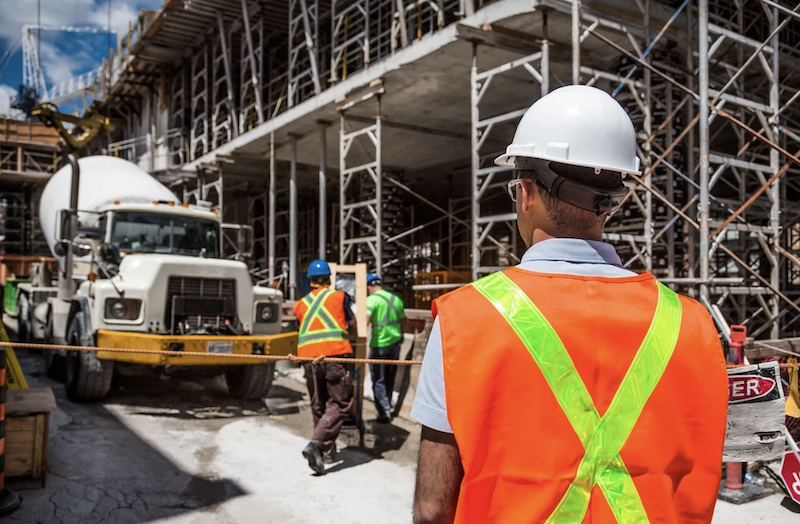Construction employment in October remained depressed compared to pre-pandemic levels in three-fourths of states despite the fact 36 states and D.C. added new construction jobs in October, according to an analysis by the Associated General Contractors of America of government employment data released today. Association officials added that demand for most types of nonresidential projects remains weak amid pandemic-related uncertainty and urged federal officials to enact a new round of coronavirus recovery measures.
“An increasing number of nonresidential contractors are experiencing cancellations that are forcing them to lay off workers,” said Ken Simonson, the association’s chief economist. “Although single-family homebuilding and remodeling contractors are adding workers, most states are likely to have a net loss of construction workers soon, especially from high-paying, nonresidential jobs.”
Seasonally adjusted construction employment in October was lower than in February—the last month before the pandemic forced many contractors to suspend work—in 37 states, Simonson noted. New York lost the most construction jobs over that span (-41,600 jobs or -10.1%), closely followed by Texas (-41,500 jobs, -5.2%). Vermont had the largest percentage loss (-21.8%, -3,200 jobs), followed by North Dakota (-13.2%, -3,900 jobs).
Only thirteen states and the District of Columbia added construction jobs from February to October. Virginia added the most (7,100 jobs, 3.5%), followed by Kentucky (4,300 jobs, 5.4%) and Alabama (4,300 jobs, 4.5%). South Dakota posted the largest percentage gain (9.4%, 2,300 jobs), followed by Kentucky.
Construction employment decreased from September to October in 12 states, increased in 36 states and D.C., and was unchanged in South Dakota and Utah. Maryland shed the most construction jobs from September to October (-2,600 jobs or -1.4%), followed by Georgia (-1,800 jobs, -0.9%). Maryland also had the largest percentage decrease, followed by Delaware (-1.4%, -300 jobs).
California added the most construction jobs over the month (26,300 jobs, 3.1%), followed by Texas (9,400 jobs, 1.3%). Alaska had the largest percentage gain for the month (10.1%, 1,500 jobs), followed by Iowa (7.0%, 4,700 jobs).
Association officials urged members of Congress to craft a new series of coronavirus relief measures to help offset declining demand for most types of nonresidential construction. Those measures must include new infrastructure investments, liability reforms to protect honest firms from unwarranted pandemic lawsuits and an extension of, and new flexibility for, measures like the Paycheck Protection Program. They also urged Congress to ensure the current administration does not move forward with its plans to tax firms that used Paycheck Protection Program loans to protect essential construction jobs.
“With the pandemic raging again in most parts of the country, countless construction jobs are at risk as owners cancel or delay construction projects amid uncertainty about the future,” said Stephen E. Sandherr, the association’s chief executive officer. “Enacting needed new recovery measures now will help protect many good-paying construction careers during what will likely be a difficult winter for the economy.”
View state employment February-October data and rankings; and September-October rankings.
Related Stories
Market Data | Oct 31, 2016
Nonresidential fixed investment expands again during solid third quarter
The acceleration in real GDP growth was driven by a combination of factors, including an upturn in exports, a smaller decrease in state and local government spending and an upturn in federal government spending, says ABC Chief Economist Anirban Basu.
Market Data | Oct 28, 2016
U.S. construction solid and stable in Q3 of 2016; Presidential election seen as influence on industry for 2017
Rider Levett Bucknall’s Third Quarter 2016 USA Construction Cost Report puts the complete spectrum of construction sectors and markets in perspective as it assesses the current state of the industry.
Industry Research | Oct 25, 2016
New HOK/CoreNet Global report explores impact of coworking on corporate real rstate
“Although coworking space makes up less than one percent of the world’s office space, it represents an important workforce trend and highlights the strong desire of today’s employees to have workplace choices, community and flexibility,” says Kay Sargent, Director of WorkPlace at HOK.
Market Data | Oct 24, 2016
New construction starts in 2017 to increase 5% to $713 billion
Dodge Outlook Report predicts moderate growth for most project types – single family housing, commercial and institutional building, and public works, while multifamily housing levels off and electric utilities/gas plants decline.
High-rise Construction | Oct 21, 2016
The world’s 100 tallest buildings: Which architects have designed the most?
Two firms stand well above the others when it comes to the number of tall buildings they have designed.
Market Data | Oct 19, 2016
Architecture Billings Index slips consecutive months for first time since 2012
“This recent backslide should act as a warning signal,” said AIA Chief Economist, Kermit Baker.
Market Data | Oct 11, 2016
Building design revenue topped $28 billion in 2015
Growing profitability at architecture firms has led to reinvestment and expansion
Market Data | Oct 4, 2016
Nonresidential spending slips in August
Public sector spending is declining faster than the private sector.
Industry Research | Oct 3, 2016
Structure Tone survey shows cost is still a major barrier to building green
Climate change, resilience and wellness are also growing concerns.
Industry Research | Sep 27, 2016
Sterling Risk Sentiment Index indicates risk exposure perception remains stable in construction industry
Nearly half (45%) of those polled say election year uncertainty has a negative effect on risk perception in the construction market.

















